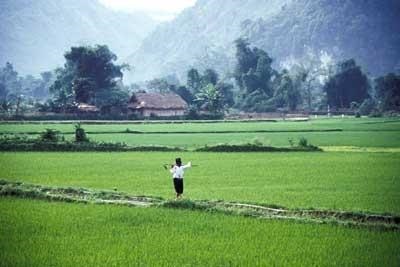
5 November 2009, Rome - The twin battles to improve food security for a growing world population and contain climate change can be fought on the same front—the world's farmland, FAO said in a new report released today.
Agriculture not only suffers the impacts of climate change, it is also responsible for 14 percent of global greenhouse gas emissions. But agriculture has the potential to be an important part of the solution, through mitigation—reducing and/or removing—a significant amount of global emissions, FAO says. Some 70 percent of this mitigation potential could be realized in developing countries.
"Many effective strategies for climate change mitigation from agriculture also benefit food security, development and adaptation to climate change," said FAO Assistant Director-General Alexander Müller. "The challenge is to capture these potential synergies, while managing trade-offs that may have negative impacts on food security."
The report, Food Security and Agricultural Mitigation in Developing Countries: Options for Capturing Synergies was launched during the Barcelona Climate Change Talks.
Down to earth
The most important technical options for climate change mitigation from agriculture are improvements in cropland and grazing land management and the restoration of organic soils and degraded lands.
Nearly 90 percent of the technical mitigation potential of agriculture comes from soil carbon sequestration. These options involve increasing the levels of organic matter, of which carbon is the main component, in soil. This can translate into better plant nutrient content, increased water retention capacity and better structure, eventually leading to higher yields and greater resilience.
Agricultural mitigation options that sequester carbon can include: low tillage, utilizing residues for composting or mulching, use of perennial crops to cover soil, re-seeding or improving grazing management on grasslands.
Balancing benefits, risks
Other options involve difficult trade-offs, with benefits for mitigation but potentially negative consequences for food security and development. In some cases, there are synergies in the long-run, but trade-offs in the short-run.
Biofuel production provides a clean alternative to fossil fuel but can compete for land and water resources needed for food production. Restoration of organic soils enables greater carbon sequestration, but may reduce the land available for food production. Rangeland restoration may improve carbon sequestration but involves short-term reductions in herder incomes by limiting the number of livestock.
Some trade-offs can be managed through measures to increase efficiency or through payment of incentives or compensation.
Many of the technical mitigation options are readily available and could be deployed immediately. But while these actions often generate a net positive benefit over time, they involve significant up-front costs.
Other barriers, such as uncertain property rights, lack of information and technical assistance or access to appropriate seeds and fertilizer, also need to be overcome. "Linking to ongoing agricultural development efforts that address these same issues is one cost effective way of doing this," said Kostas Stamoulis, Director of the FAO Agricultural Development Economics Division.
Financing mechanisms needed
The report outlines possible design features for financing mechanisms that could help unlock agriculture's potential benefits for climate change mitigation, food security and agricultural development.
A range of financing options—public, public-private and carbon markets—are currently under negotiation for climate change mitigation actions in developing countries. These could be future sources of finance for agricultural mitigation actions, the report says, as could a dedicated international fund to support agricultural mitigation in developing countries and coordination with financing from official development assistance for agricultural development.
Capturing agriculture's multiple benefits
Despite its significant potential, agricultural mitigation has remained relatively marginal within the climate change negotiations.
To capture the multiple benefits of agriculture. the report recommends a work programme on agricultural mitigation within the UNFCCC Subsidiary Body for Scientific and Technological Advice to help address methodological issues related to implementation. It also proposes country-led piloting of action and field testing, using a phased approach linked to national capabilities and supported by capacity building and financial/technology transfers.